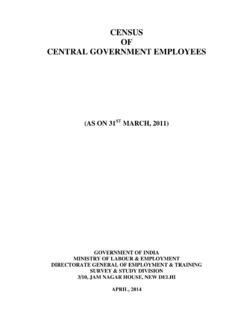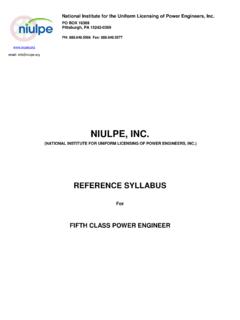Transcription of Syllabus for the Trade of ELECTRONICS MECHANIC
1 Syllabus for the Trade of ELECTRONICS MECHANIC (SEMESTER PATTERN) UNDER CRAFTSMAN training SCHEME Re-designed in 2014 By Government of India Directorate General of Employment & training Ministry of Labour & Employment (DGET) 2 GENERAL INFORMATION 1. Name of the Trade : ELECTRONICS MECHANIC 2. NCO Code No. : , , 3. Duration : 02 years (Four semesters having duration of six months each) 4. Power Norms : kW 5. Space Norm : 56 Sq mtrs 6. Entry Qualification : Passed 10th class examination under 10+2 system of education. 7. Unit Size (No. of Students) : 20 Trainees 8. Instructor s/Trainer s Qualification : 9. Desirable qualification : Preference will be given to a Instructors Certificate (CIC).
2 Note: At least one Instructor must have Degree / Diploma in the relevant field. a) in ELECTRONICS / ELECTRONICS & Telecommunication / ELECTRONICS & Communication with one year experience in the relevant field OR b) Diploma in ELECTRONICS / ELECTRONICS & telecommunication/ ELECTRONICS & Communication from recognized board of technical education with two years experience in the relevant field. OR c) NTC/NAC in the Trade with three years experience respectively in the relevant field COURSE INFORMATION Trade :- ELECTRONICS MECHANIC 1. Introduction :- This course is meant for the candidates who aspire to become Technician to Service different ELECTRONICS based System/Equipment.
3 2. Deliverables: After successful completion of this course the trainee shall be able to perform the following skills with proper sequence. 1. Identify various active and passive components and their applications. 2. Handle different types of electronic measuring Instruments 3. Identify different types of faults in ELECTRONICS equipments. 4. Repair & maintenance computer hardware & networking 5. Repair and maintenance of SMPS, UPS, Inverter, solar power system and various analog and digital circuits. 6. Repair and maintenance of ELECTRONICS communication equipments and fiber optics. 7. Installation of various transducer, sensor. 8. Repair maintenance of microcontroller based systems. 9. Repair maintenance& installation of LED/ LCD TV, Cell phone (Mobile).
4 Employment Opportunities: On successful completion of this course, the candidates shall be gain fully employed in the following industries: 1. Various ELECTRONICS Equipment Manufacturing Industries. 2. Automobile ELECTRONICS and allied industries 3. Industries manufacturing Solar power based inverters. 4. Industries manufacturing LED Lights 5. Service industries like BSNL, MTNL, Home appliances manufacturing company, Railways, ISRO, Naval dockyard, RCF, BPCL etc. 6. Various Mobile industries like LG, Samsung, Nokia, Sony etc. 7. In public sector industries like BHEL, BEML, NTPC, etc and private industries in India & abroad. Petrochemical industries like ONGC, IOCL, HPCL etc 8. Self employment Further learning pathways: On successful completion of the course, trainees can opt for additional NCVT certificates in the following courses by doing the Third and Forth semester since the first and second semester is common for all three ELECTRONICS courses.
5 1) MECHANIC electronic Consumer appliance (Only 4th Semester) 2) Technician Power ELECTRONICS Systems (3rd and 4th Semester) Also on successful completion of the course they can pursue Apprenticeship training in the reputed Industries / Organizations. They can have lateral entry to Diploma course 4 Syllabus for the Trade of ELECTRONICS MECHANIC Duration: 6 Months First Semester Semester Code: ELM: SEM I Fundamentals of Electrical and electronic components OBJECTIVES: Familiarize with basics of electricity Identify and Use different hand tools Testing of electrical parameters, cables and measurements Identify and test cells/batteries Identify and test passive electronic components Use electronic components in different circuits Practice soldering and de-soldering of various types of electrical and electronic components Identify and test semiconductor devices identify , disassemble, and assemble a computer system replace various functional parts HDD, CDD, SMPS, Memory etc Practice of OS, Clean the system using Antivirus software and maintain the computer system Work with MS office packages Familiarize with internet browsing, creation of mail IDs.
6 Download desired data from internet using search engines 5 Syllabus FOR Trade PRACTICAL AND Trade THEORY SEMESTER-I Week No Trade practical Trade theory 1 Trade and Orientation Visit to the institute and workshops. Introduction with the principal and other staffs. Care and safe working habits, safety precautions to be demonstrated to the trainees. Elementary first aid practice. Identify different types of fire extinguishers. Do s and Don ts and standard practices to be followed in the institute Introduction to NCVT and certification mechanism. Semester system and its flexibility for the trainee and to the institute. EM Trade and its applicability in industries. Expectations of the industry from trainees after the completion of the Trade .
7 The skills to be acquired to become part of industry. Introduction to safety, safety signs, and measures to be taken to maintain the standards of safety of personal working and the equipments. Different first aid mechanisms to rescue the affected by electric shocks or any physical injuries. 2 3 Hand Tools and their uses Demonstration and uses of hand tools- screw drivers, pliers, tweezers, tester, wire stripper, electrician knife, steel rule, scriber, punches, hack saw, hammer, files, bench vice and drilling machine. Simple mechanical fixtures Identification of types of screws, bolts, nuts, washers, rivets, clamps, connectors Fix screws of different sizes on wooden boards Cutting of wooden blocks using hand/hack saw Simple fitting practice and drilling practice Simple sheet metal works Identification, specifications, uses and maintenance of commonly used hand tools.
8 Riveting of tags and lugs, cutting and bending of sheet metals, chassis and cabinets. 4 5 Basics of AC and Electrical Cables Identify the Phase, Neutral and Earth on power Socket. Construct a test lamp and use it to check mains healthiness. Use a Tester to monitor AC power. Measure the voltage between phase and Basic terms such as electric charges, Potential difference, Voltage, Current, Resistance. Basics of AC & DC. Terms such as +ve cycle, -ve cycle, Frequency, Time period, RMS, Peak, P-P, Instantaneous value. Single phase and Three phase supply. Terms like Line and Phase voltage/ currents. Insulators, conductors and 6 ground and rectify earthing. Identify and test different AC mains cables.
9 Skin the electrical wires /cables using the wire stripper and cutter. Measure the gauge of the wire using SWG. Prepare the mains cable for termination. Crimp the lugs to wire end and Solder the lugs to wire end Solder/crimp/terminate different types of electrical connectors Measure AC and DC voltages using multi meter. semiconductor properties. Different type of electrical cables and their Specifications. Types of wires & cables, standard wire gauge(SWG). Classification of cables according to gauge(core size), number of conductors, material, insulation strength, flexibility etc. 6 Cells & Batteries Identify the primary and secondary cells Measure and test the voltages of the given cells/battery using analog / digital multimeter.
10 Charging and discharging the battery. Maintain the secondary battery. Use a hydro meter to measure the specific gravity of the secondary battery. Battery /Cells: construction, types of primary and secondary cells, materials used, Specification of cells and batteries. Charging process, efficiency, life of cell/battery. Selection of cells / Batteries etc. Use of Hydrometer. Types of electrolytes used in cells and batteries. Series / parallel connection of batteries and purpose of such connections. 7-9 Passive Components Identify the different types of resistors Measure the resistor values using colour code and verify the reading by measuring in multi meter Identify the power rating using size Verify ohms law Measure the resistance, Voltage, Current through series and parallel connected networks using multi meter Identify different inductors and measure the values using LCR meter Identify the different capacitors and measure capacitance of various capacitors using LCR meter Make an electro magnet.











